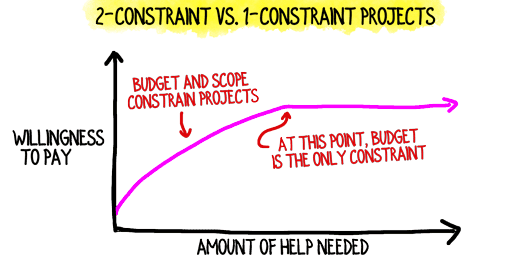“Colorado Pricing.” A Lucrative Fee Arrangement for Your Consulting Firm?
If your consulting firm’s offerings are suited for it, Colorado Pricing could increase your revenue and profitability while smoothing out the up/down cycle of consulting.
2-Constraint vs. 1-Constraint Consulting Projects
Quite a lot of consulting consists of discrete, one-and-done projects.
For instance, Cadbunny’s chocolate chips are melting, so they hire your consulting firm for $150K. You lower the thermostat on their chiller. Done. You and the Cadbunny execs shake hands and move on with your lives until/unless another problem crops up.

This type of consulting work operates under two constraints:
- A fixed scope with reasonably well-defined boundaries, and
- The client’s willingness to pay.
However, certain clients and certain types of consulting practices operate with only one constraint: the client’s willingness to pay.
One-constraint projects present no meaningful limit to the scope of work. Perhaps the client’s needs are ever-present, evergreen and recurring, or perhaps the scope of work is so large and the timeline to complete the work is so long, that limits aren’t worth considering.
For example, say Cadbunny situated their chocolate chip factory in a location with wildly fluctuating temperature and humidity. Further, every batch of raw cacao has slightly different melting points, and Cadbunny’s broad, ever-changing roster of customers specify inconsistent requirements for chip meltiness.
In this instance, your client needs ongoing analysis and support, plus a deft, experienced touch to keep operations running smoothly.

Other examples of one-constraint consulting opportunities include:
- Technical/IT-work that is perpetual and somewhat commoditized;
- Annual strategic planning;
- Ongoing pricing support for a large company with numerous offerings;
- Perennial voice-of-customer research;
- Training-heavy transformation efforts for organizations with a steady flow of new personnel.
Colorado Pricing
One-constraint consulting lends itself to Colorado Pricing.
Since the work is ongoing and, for all intents and purposes, limitless, your goal is to engage with the client for many years, earning a steady stream of profitable revenue.
Colorado Pricing anchors on a single question to your prospect:
“What fee would make it easy for you to say we could work together forever?”
In context, it sounds like this:
“Ms. Chocoman, there’s a ton of work to do here at Cadbunny, and your needs are perfectly aligned with our expertise. I’d like us to be partners for the long term. So, what fee—monthly or quarterly or annually—would make it easy for you to say we could work together forever? I’ll scope out what we can do for that fee to constantly produce a fabulous return. If you ever feel less than thrilled with the arrangement, we’ll adjust.”
After the client offers you her forever number, you determine what work your consulting firm can deliver for that periodic fee and confirm it with the client. Then you lock in a long-term, steady, reliable, profitable contract.
Your client’s periodic fee will usually be lower than you’d like for a short-term engagement, and much lower than you’d want for a two-constraint project.
For instance, instead of $150K for a project or $35K/month for a four-month engagement, Ms. Chocoman might suggest $15K/month as Cadbunny’s “forever” fee.
Jump on that $15k/month. Over your multi-year partnership, your consulting firm will have earned far more from Cadbunny than you would have collected for the short-term project.
Plus, since you’re constantly engaged with Cadbunny, you’re very likely to find expansion opportunities or supplemental, short-term projects.
A dollop of dependable, predictable work for your team creates a platform for your consulting firm to experiment with more speculative projects and firm-building ventures.
Will Colorado Pricing Work for Your Consulting Firm?
To employ Colorado Pricing effectively, your consulting firm must deliver well and efficiently. Ideally, your combination of people, approaches and systems allow your firm to over-deliver on expectations vs. “typical” market rates.
If your consulting firm’s work is average, or slow, or you strive to deliver totally bespoke work with expensive resources, Colorado Pricing won’t work well for you.
We’ve seen some firms absolutely thrive with Colorado pricing. Have you tried anything like it at your firm?*
Text and images are © 2024 David A. Fields, all rights reserved.

 David A. Fields Consulting Group
David A. Fields Consulting Group 


Interesting concept! Thank you, David. Why is it called “Colorado Pricing”?
It’s called Colorado Pricing because the first firm I encountered that used this approach was based in Colorado. As the hover-over asterisk at the end of the article says, sometimes names aren’t clever or deep!
Thanks for the question, Karen!
Ah. Thank you. I didn’t notice the asterisk. Do you see any difference between Colorado pricing and setting monthly retainers? I used that model a lot in my firm’s early days and found it difficult to keep clients engaged month in and month out due to the degree of distraction that existed internally (which is precisely why they needed ongoing support). Any thoughts re this? Thanks, again. Your posts are always thought-provoking and practical. And make me chuckle as well!
The asterisks elude many readers of many articles. You’re in good company, Karen. Yes, there’s absolutely a difference between Colorado Pricing (which is a fee-setting approach) and Retainers and Stipends. See my replies to Amelia and Christin, which explore the differences between these pricing concepts.
In terms of “keeping a client engaged” for many months (or years): for Colorado Pricing to be appropriate, your consulting needs to either 1) create high perceived value without client engagement, or 2) be perceived as a limitless amount of important, valuable work. Whether or not you think the important work is limitless is irrelevant. As an excellent Right-Side Up consultant, you know consulting is about your clients, not you. That’s why you correctly switched your pricing approach to project fees for project work.
Terrific follow-on question, Karen!
Off topic but…I was this many days old when I finally found out how to read what was behind the blog asterisks. You have no idea what a relief this is! Thanks for the always great content, David…and now the secret to the asterisk easter egg
That’s so funny, Rick. Congratulations on entering the “in” crowd!
For years, my team has insisted (correctly) that I not include any critical concepts in hover-over/asterisk text because many readers miss the asterisks or use devices that make hover-over difficult. Hence, most asterisked content consists of puns, obscure references, and relevant-but-unimportant side notes.
When you join the group of readers that counts the number of puns hidden in each week’s article, then you’ll know you’re really far down the rabbit hole!
Thank you for reading, commenting and adding a smile, Rick.
We do exactly this for our post-implementation clients. We offer them two pricing/support models. The first is a traditional “Bucket of Hours”. We have a pre-paid minimum that makes it worth our time and makes sure that they are serious. After that, they can draw down from the authorized bucket and we bill them by the hour. I tell the client that the disadvantage is a) the hourly pricing is high and b) they can’t assume that we will have a resource available as soon as they need it.
The alternative is a contract for a certain number of hours per month (the number is up to the customer). For this contract, we guarantee rapid response and a discounted hourly rate. The hours don’t roll over from month to month, though we will “steal” from the end of the contract to allow for a surge in a specific month. We find that this model has distinct advantages. We lock the client in for a term, usually 12 months, and they usually renew. We also have visibility into new, bigger projects that we can upsell on top of the existing support contract. It has been a win for us.
Excellent example, Derek. The two models you describe are slightly different from Colorado Pricing, because in Colorado pricing, there isn’t hourly tracking or an hourly rate, per se– at least not visibly. Behind the scenes, of course, it’s crucial to keep track of the amount of effort being expended over time and to revisit with the client every six months or so to ensure that the client is happy with the value and your firm is running the relationship profitably.
One of the trickier aspects of Colorado Pricing that I didn’t delve into in the article is the distinction between scope, which is focused on outcomes or issues addressed, and hours. That said, your example is very close to Colorado Pricing and is one that many firms would be wise to consider.
Thanks for chiming in on the discussion, Derek!
How is Colorado Pricing different from a retainer fee? (Or is it just the same thing, different word)?
Great question, Amelia. It’s worth distinguishing between “retainers,” “stipends” and Colorado Pricing.
I typically don’t talk much about retainers, because they’re more appropriate for attorneys and other professions that charge by the hour. In a retainer, the client “retains” your services by depositing a pot of money, which the client then draws against at an hourly rate until the pot reaches a certain level, at which point the pot is replenished. It’s a dollars-for-hours fee arrangement with a pay-in-advance mechanism.
Stipends are regular, fixed periodic payments. They occur regardless of the amount of work done or hours expended. Many consultants refer to a contract as a retainer when, in fact, stipend would be the more accurate description. Derek’s example in the comment above (or below?) is an excellent application of a stipend, and is probably somewhat of a mix between Colorado Pricing (an approach to fees) and stipends (a payment mechanism). Stipends are most commonly used (and best suited) for advisory work, in which the client is paying for access, not effort or output.
Colorado Pricing isn’t a payment mechanism. It’s an approach to setting fees for consulting work that produces output. While the payment mechanism looks like a stipend–a recurring, periodic fee, Colorado Pricing isn’t based on a number of hours with a pre-determined rate or based on a pre-determined fee for a certain level/type of access. Rather, it’s based on a scope of output/outcomes that fits within a budget the client determines.
The nuances between these three pricing concepts is one reason I haven’t written about Colorado Pricing before. There’s a lot to explain in less than 700 words, and the ideas can be difficult to master. On the other hand, we’ve seen extraordinary results for firms that fully grok the concept of Colorado Pricing and implement it well.
Thank you for creating an opportunity to explain the ideas further, Amelia!
This article was very helpful, David. I’ve been working with a client for 9 months where we’ve been discussing each month, what to work on the following month and it’s been challenging for the client to come up with projects as he is unclear about what his business needs. We are currently in talks about whether or not to continue our work together, as he is shopping other consultants and I see that, according to your article, by offering him a roadmap of projects, I can offer more value to him. Thank you!
Your situation is very instructive, Christin. One of the reasons we typically advise against mixing a stipend payment approach (fixed, periodic payments) with project work is exactly the scenario you describe: the client and consultant have to come up with work to justify the fees, the attention starts moving to hours of effort, and unhappiness ensues. The exception–and this is when Colorado Pricing applies, is when the client and consultant agree that there is so much work to be done, that it’s basically endless (or at least will take years).
If you lay out a multi-year roadmap of work to be done and your client agrees, then you’ll be back to a Colorado Pricing situation. Otherwise, you should convert to project pricing.
I very much appreciate your sharing your situation, Christin. It’s a great example and gives the opportunity for to dig deeper into optimal contracting.
Great article David. This type of arrangement is my favorite for a couple of reasons. First, (I think you touched on this in the Monday Live meeting), the ways I can benefit clients often evolves once the engagement begins. The Colorado approach offers the client (and me) latitude to address needs that may not have been atop their list when the engagement scope was defined. Second, it tends to be easier in terms of contracting. Much of my work is with financial institutions, and once we get through their vendor diligence work, it’s just easier for them to have a more open engagement (vs. a separate statement of work for each new node of work).
Two very good points, Dave. You’re absolutely right. Colorado Pricing, because it’s viewed as a long-term partnership rather than project work, allows for easy adjustments of priorities. Also, as you note, it’s much easier to keep a single contract running than to constantly renew contracts.
I’m glad you added your smarts to the conversation, Dave!